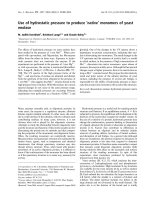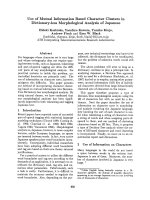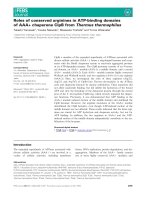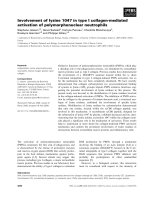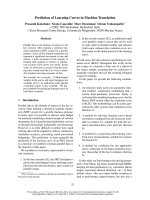Báo cáo khoa học: "Use of soft X-radiography for early non-destructive detection of floral differentiation in Douglas fir buds" pptx
Bạn đang xem bản rút gọn của tài liệu. Xem và tải ngay bản đầy đủ của tài liệu tại đây (965.49 KB, 9 trang )
Original
article
Use
of soft
X-radiography
for
early
non-destructive
detection
of
floral
differentiation
in
Douglas
fir
buds
(Pseudotsuga
menziesii (Mirb)
Franco)
M Bonhomme
P
Doumas
M
Bonnet-Masimbert
R Rageau
1
INRA-Université
Blaise-Pascal,
Unité
Associée
Physiologie
Intégrée
de
l’Arbre
Fruitier
(PIAF),
Domaine
de
Crouelle,
F63039
Clermont-Ferrand
CEDEX
2;
2
INRA,
Station
d’Amélioration
des
Arbres
Forestiers,
F45160
Olivet
,France
(Received
22
March
1993;
accepted
9
September
1993)
Summary —
Weekly
X-radiographs
were
made
of
Douglas
fir
buds
on
growing
shoots
as
a non-
destructive
method
of
detecting
the
onset
of
their
meristem
transition
from
a
vegetative
to
a
floral
state.
The
same
procedure
was
followed
with
sampled
shoots
to
improve
the
interpretation
of
previous
radiographs
made
of
whole
branches
on
the
tree.
There
was
clear
evidence
of
the
floral
state
about
60
d
after
the
beginning
of
the
flower-promoting
treatment.
Male
and
female
cones
were
plainly
distin-
guishable
75 80
d
after
the
treatment.
With
this
technique,
it
is
possible
to
non-destructively
follow
the
growth
of
floral
primordia
inside
the
buds.
The
technique
can
also
be
used
to
characterize
bud
samples
on
the
basis
of
more
accurate
criteria
than
those
of
external
morphology.
Good
results
were
obtained
on
freeze-dried
buds,
particularly
for
showing
vascularization
at
the
bud
base.
Pseudotsuga
menziesii /
X-radiography
/
floral
bud
/
floral
initiation
Résumé—
Utilisation
de
la
radiographie
aux
rayons
X
pour
une
détection
précoce
de
la
diffé-
renciation
florale
des
bourgeons
du
sapin
de
Douglas
(Pseudotsuga
menziesii (Mirb)
Franco).
Sur
de
jeunes
plants
de
sapin
de
Douglas
nous
avons
réalisé
chaque
semaine
au
cours
du
mois
d’août
1991
une
série
de
radiographies
RX
sur
les
bourgeons
des
pousses
en
croissance
afin
de
mettre
en
évidence
précocement,
mais
de
façon
non
destructive,
le
passage
de
l’état
végétatif
à l’état
floral.
Les
mêmes
observations
ont
été
faites
en
parallèle
sur
des
pousses
prélevées,
pour
affiner
les
interprétations
des
clichés
réalisés
sur
rameaux
en
place
sur
l’arbre.
Le
passage
à
l’état
floral
a
pu
être
détecté
de
façon
certaine
environ
60 j
après
le
début
d’application
du
traitement
florifère.
La
distinction
entre
ébauches
florales
mâles
et
femelles
ne
fait
plus
de
doute
80 j
après
cette
même
date.
Cette
technique
permet
donc
de
suivre
de
façon
non
destructive
la
croissance
des
ébauches
à
l’intérieur
des
bourgeons.
Elle
peut
également
être
utilisée
pour
caractériser
des
lots
de
bourgeons
sur
des
critères
plus
discriminants
que
ceux
basés
sur
la
seule
morphologie
externe.
La
technique
est
utilisable
sur
des
rameaux
lyophilisés
chez
lesquels
elle
permet,
notamment,
de
mettre
en
évidence
la
vascularisation
à
la
base
des
bourgeons.
Pseudotsuga
menziesii
/ radiographie
RX/bourgeon
floral/initiation
florale
INTRODUCTION
The
effectiveness
of
X-radiography
to
deter-
mine
seed
quality
has
been
confirmed
by
its
extensive
use
over
a
number
of
years
(Simak
and
Gustafsson,
1953;
Simak
and
Sahlen,
1981;
Chavagnat,
1984,
1985).
Radiographs
provide
morphological
infor-
mation
about
organs
or
tissues
which
would
otherwise
be
masked
by
others,
while
pre-
serving
plant
specimens
intact.
With
this
technique,
it
is
possible:
(i)
to
obtain
pre-
cise
information
on
the
morphogenetic
development
of
the
plant
of
particular
inter-
est
for
ontogenetic
studies;
and
(ii)
to
have
a
more
accurate
definition
of
the
state
or
the
development
stage
of
organs
and
tissues
for
sampling,
especially
for
sparse
material.
Studies
on
conifer
bud
initiation/differ-
entiation
and
development
provide
excel-
lent
examples
of
the
potential
use
of
this
technology.
Reproductive
events
take
place
in
axillary
buds
during
the
course
of
the
vegetative
development
of
the
elongating
shoot.
The
only
way
to
confirm
the
pres-
ence
of
sexual
buds
is
to
use
destructive
methods
such
as
histology
or
to
wait
until
bud
development
is
complete,
when
it
is
possible
to
differentiate
morphologically
male,
female
and
vegetative
buds.
Floral
ontogenesis
in
cone
buds
and
the
features
and
conditions
by
which
it
is
deter-
mined
are
important
in
forest
tree
breeding,
in
which
research
has
been
confined
to
the
use
of
destructive
methods.
Thus,
we
tried
to
detect
the
transition
from
vegetative
to
floral
state
non-destructively
using
the
radio-
graphy
of
buds.
The
present
work
is
to
our
knowledge
the
first
to
use
X-radiography
to
study,
in
situ,
floral
initiation
on
Douglas
fir
buds.
MATERIALS
AND
METHODS
To
increase
the
likelihood
of
obtaining
enhanced
cone-bud
production,
potted
5-year-old
grafts
of
Douglas
fir
(Pseudotsuga
menziesii)
were
sub-
mitted
to
different
flower-inducing
treatments
(Bonnet-Masimbert,
1987,
1989)
at
time
of
bud
burst
in
1991.
Trees
1,
2,
and
3
received
bark
girdle
and
root-flooding
treatments.
Girdles
were
double,
overlapping,
half
circumferential
bands
(5
mm
wide).
Root
flooding
was
alternated
(2.5
d
in
water
with
2.5
d
out
of
water
over
15
d).
Trees
4
and
5
were
treated
with
hormonal
injection
and
bark
girdles.
Gibberellin
4/7
(20
mg)
and
naph-
thalene
acetic
acid
(2
mg),
in
100
μl
methanol
were
injected
directly
into
the
trunk
(5
mm
depth).
For
each
tree,
several
shoots
located
on
the
1990
whorls
were
selected
for
X-radiography
in
situ.
During
the
shoot-growth
period,
we
made
weekly
radiographs
of
these
shoots:
for
conve-
nience,
the
potted
plants
and
generator
were
moved
near
an
electric
power
supply.
Radio-
graphs
were
made
in
accordance
with
safety
reg-
ulations.
Young
shoots
with
morphologic
characteristics
similar
to
those
of
previous
shoots
(vigour,
pres-
ence
and
distribution
of
young
buds)
were
also
selected
for
the
collection
of
bud
samples
through-
out
the
period
of
experimentation.
Samples
(3
shoots
per
tree
giving
20-40
buds)
were
collected
about
once
every
2
weeks
(July
22
for
tree
num-
ber
1,
July
31
for
trees
1-5,
August
13
for
trees
1-5,
August
22
for
trees
1-3,
August
26
for
trees
4
and
5,
and
September
2
for
trees
1-5).
At
each
sampling
date,
the
shoots
were
X-rayed
in
a
shielded
chamber
after
removal
of
the
needles
and
then
immediately
put
in
liquid
nitrogen
and
freeze-dried.
After
freeze-drying,
new
radiographs
were
made.
During
exposure,
shoots
were
taped
on
the
film
(taking
care
that
there
was
no
inter-
ference
between
adhesives
and
bud
pictures)
to
reduce
geometric
fuzziness
as
much
as
possible.
Radiography
was
performed
with
an
Andrex
160
kV
generator
with
a
beryllium
window
pro-
ducing
soft
X-rays
(15
kV);
the
intensity
was
set
at
3
mA
and
focus
distance
at
1
m.
Exposure
time
was
about
5
min.
Films
(double-coated
and
’medium’
relative
speed
Kodak
Industrex
M
in
’Ready
Pack’)
were
developed
in
manual
Kodak
Industrex
developer
for
5
min
at
20 °C,
fixed
for
5-6
min
in
Kodak
fixer
(20°C)
and
thoroughly
rinsed
in
running
water.
Histologic
sections
of
buds
sampled
at
the
last
date
of
observation
were
made
with
a
cryo-
microtome
and
stained
with
carmine-green
solu-
tion
(Johansen,
1940)
to
compare
bud
anatomy
with
the
findings
from
the
radiographs,
in
partic-
ular,
of
freeze-dried
buds.
Radiographs
of
cut
shoots
Sixty-five
days
after
floral
treatment
(August
13)
or
fifty-five
days
after
treatment
(July
31)
for
tree
1
with
the
earlier
development,
the
radiographs
generally
showed
a
marked
increase
in
the
size
of
the
apparent
meri-
stematic
dome
which
expressed
the
floral
transformation
(fig
1).
At
this
stage,
it
was
not
yet
possible
to
distinguish
between
male
and
female
parts.
However,
because
of
the
position
of
the
buds
on
the
shoot,
tentative
conclusions
could
be
drawn
concerning
the
nature
of
the
flowers.
As
expected,
radio-
graphs
of
buds
made
on
cut
shoots
(fig
2a)
had
a
sharper
definition
than
those
made
in
situ
on
trees
(fig
2b).
In
the
samples
of
August
22
(80-85
d
after
treatment),
the
space
between
the
bud
scales
near
the
apparent
meristematic
dome
was
greater
than
in
those
taken
August
13
(65
d
after
treatment)
and
the
vegetative
or
floral
state
of
the
buds
was
clearly
appar-
ent
(fig
3).
In
addition,
it
was
possible
to
characterize
the
female
buds
by
the
flat-
ness
of
their
apparent
apical
dome
(meri-
stem
and
bracts
of
floral
part).
The
images
in
figure
3
can
be
usefully
compared
with
those
of
dissected
buds
in
figure
4.
Because
of
their
size
and
their
position
on
the
shoot,
only
a
percentage
of
buds
present
could
be
observed
and
interpreted
on
a
single
radio-
graph.
Table
I shows
that
this
percentage
depends
on
the
state
of
bud
development
on
the
tree
and
the
date
of
shoot
sampling.
Radiographs
of
shoots
on
trees
The
pictures
of
buds
taken
in
situ
(fig
5)
were
more
difficult
to
interpret
than
those
from
the
excised
shoots
because
of
the
dif-
ficulty
of
laying
the
buds
correctly
onto
the
film
during
exposure,
which
created
greater
fuzziness,
and
also
because
the
pictures
of
the
buds
and
needles
were
super-
imposed.
A
lower
proportion
of
in
situ
buds
than
buds
that
had
been
excised
and
X-rayed,
were
thus
able
to
be
analysed.
On
a
given
date,
this
percentage
depended
on
the
ear-
liness
of
the
tree
phenology
and
the
posi-
tion
of
the
buds
on
the
shoot.
The
percent-
age
of
the
buds
that
could
be
analysed
increased
overall
with
time
as
did
the
size
of
the
buds,
from
a
small
percentage
on
August
5
(2-30)
to
almost
the
total
number
of
buds
on
September
3
(table
II).
The
date
of
floral
transformation
of
some
of
the
buds
in
these
radiographs
was
esti-
mated
as
being
the
same
as
on
the
excised
shoots.
For
the
population
of
buds
present
on
selected
shoots
on
the
tree,
an
overall
interpretation
was
made
from
data
collected
on
August
12
(trees
1,
4,
5)
or
August
20
(trees
2,
3).
Radiographs
of
freeze-dried
buds
The
radiographs
of
buds
made
after
shoots
had
been
freeze-dried
had
much
detail
(fig
6).
However,
we
could
only
distinguish
between
the
different
kind
of
buds
10
d
later
than
those
from
radiographs
made
of
’fresh’
buds.
This
was
probably
due
to
a
retraction
of
the
structures
during
freeze-drying,
which
induced
a
reduction
in
the
overall
size
of
the
floral
parts.
The
proportional
size
of
the
structures
was
however
unchanged.
Radiographs
of
lyophilised
material
showed
vascularization
at
the
base
of
the
bud.
Parallel
observations
of
histologic
sec-
tions
of
homologous
buds
(fig
7)
showed
that
there
was
xylem
vascularization
in
the
shoot
and
procambium
with
proto-xylem
at
the
base
of
the
buds.
In
Douglas
fir
buds,
we
observed
the
presence
of
a
transition
zone
with
enlarged
parenchymatous
cells
corresponding
to
the
crown
region
described
by
Allen
and
Owens
(1972),
delimiting
a
’chamber’
at
the
base
of
the
buds,
which
quickly
changed
in
shape
and
size
under
floral
buds.
Whether
the
floral
bud
was
male
or
female,
the
structure
of
the
chamber
was
the
same
but
its
development
seemed
slower
under
male
buds.
This
difference
could
be
an
additional
criterion
in
the
inter-
pretation
of
radiographs
made
at
a
very
early
stage.
DISCUSSION
AND
CONCLUSION
X-radiography
is
commonly
used
to
deter-
mine
the
quality
of
different
seed
samples
(Chavagnat,
1984)
and
its
non-destructive
nature
has
been
widely
confirmed.
This
characteristic
is
of
great
interest
in
experi-
ments
in
which
growth
phenomena
are
stud-
ied
because
it
allows
the
repeated
obser-
vation
of
a
specific
organ,
thus
avoiding
the
difficulties
of
sampling
homogeneity.
Although
we
did
not
check
it
on
the
buds,
it
seems
highly
improbable
that
chromosomic
damage
appeared,
because
of
the
small
doses
of
radiation
accumulated
(25
rads
for
1
h
of
exposure
which
represents
about
12
pictures)
compared
to
the
LD50
,
about
20
000
rads
for
seeds,
or
to
the
doses
used
to
induce
mutagenesis
in
apple
or
pear
buds
(2 000
to
5
000
rads).
It
therefore
seemed
useful
to
adapt
this
technique
to
a
material
like
conifer
buds.
Although
they
present
certain
disadvan-
tages
(they
are
thicker
than
seeds
and
have
a
higher
water
content)
previous
attempts
on
other
species
gave
promising
results
(Chavagnat,
1988).
We
did
encounter
drawbacks
with
the
X-
ray
technique.
In
particular,
the
inability
to
obtain
pictures
precise
enough
for
the
obser-
vation
of
the
meristematic
apex
made
it
impossible
to
apply
the
height/width
ratio
of
the
apical
meristem
used
by
Owens
and
Smith
(1964),
Owens
(1969),
and
Allen
and
Owens
(1972)
to
describe
the
anatomical
development
of
the
meristem.
However,
we
did
observe
some
early
morphologic
differences
and
precise
changes
in
structure.
The
analysis
of
floral
morphology
must
be
associated
with
an
analysis
of
the
morphology
of
the
buds
(shape
and
angle
of
scale
insertion)
to
dis-
tinguish
very
early
vegetative
buds
from
flo-
ral
buds
and
to
differentiate
between
male
and
female
floral
buds.
We
were
unable
to
achieve
pictures
as
sharp
as
those
obtained
with
seeds
but
can
foresee
interesting
applications .
The
growth
and
development
of
floral
parts
inside
buds
could
be
studied
non-destructively,
thereby
allowing
precise
kinetic
studies
on
small
quantities
of
material.
Homogeneous
sam-
ples
of
buds
could
be
selected
in
situ
on
the
basis
of
their
real
state
(for
later
biochemical
analysis,
for
example)
at
a
stage
when
exter-
nal
morphological
characteristics
would
make
it
impossible.
Improvements
in
the
definition
of
radio-
graphs
can
be
expected
and
we
are
confi-
dent
that
there
will
be
greater
future
devel-
opments
of
this
technique
in
biology.
ACKNOWLEDGMENTS
We
particularly
thank
A
Chavagnat
for
introducing
us
to
the
radiography
technique
and
for
his
very
useful
advice.
We
also
thank
C
Bodet,
P
Delanzy,
N
Frizot
and
JP
Richard
for
technical
assistance.
REFERENCES
Allen
GS,
Owens
JN
(1972)
The
Life
History
of
Douglas
Fir.
Ed
Environment
Canada
Forestry
Service,
139
p
Bonnet-Masimbert
M
(1987)
Floral
induction
in
conifers:
a
review
of
available
techniques.
For
Ecol
Manage
19, 135-146
Bonnet-Masimbert
M
(1989)
Promotion
of
flowering
in
conifers:
from
the
simple
application
of
a
mixture
of
gibberellins
to
more
integrated
explanations.
Ann
Sci For 46
(suppl),
27s-33s
Chavagnat
A
(1984)
Determination
de
la
qualité
des
semences
horticoles
par
radiographie
industrielle
aux
rayons
X.
PHM
Revue
Horticole
249, 57-61
Chavagnat
A
(1985)
La
radiographie
industrielle
aux
rayons
X.
Contrôle
de
la
qualité
des
semences
et
autres
applications
en
agronomie.
CR Acad Agri Fr
71,
5, 457-463
Chavagnat
A
(1988)
Nouveau:
la
radiographie
indus-
trielle
aux
rayons
X
pour
la
protection
des
plantes.
Phytoma 401,
13-21
Johansen
D
(1940)
Plant
Microtechnique.
McGraw
Hill
Book
Company
Inc,
New
York,
59
pp
Owens
JN
(1969)
The
relative
importance
of
initiation
and
early
development
on
cone
production
in
Dou-
glas fir.
Can J Bot 4,
1039-1049
Owens
JN,
Smith
FH
(1964)
The
initiation
and
early
development
of
the
seed
cone
of
Douglas
fir.
Can
J
Bot 42,
1031-1047
Simak
M,
Gustafsson
A
(1953)
X-photography
and
sen-
sibility
in
forest
tree
species.
Hereditas
39,
458-468
Simak
M,
Sahlen
K (1981)
Report
of
the
forest
tree
seed
committee
working
group
on
X-testing
1977-1980.
Comparison
between
the
X-radiography
and
cutting
test
used
in
seed
quality
analysis.
Seed Sci
Technol
9,
1, 205-227



